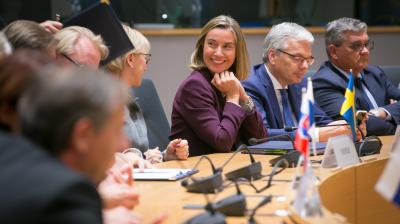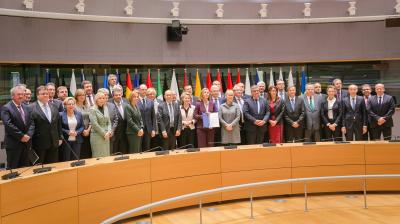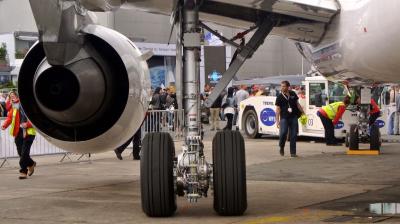This outlook analysis was originally published in the "European Defence Matters, No. 17". In this special edition The European Defence Agency celebrates its 15th anniversary. Our Head of the Security Unit, Dick Zandee, offers an interesting and inspiring outlook analysis (Quo Vadis, EDA?). What lies ahead in the next 15 years? The Agency has to be at the centre of European military capability development.
Since its creation in 2004, expectations about the future of EDA were high. The founding fathers had learned from the past to avoid a stove-piped institution solely focussed on one single area of capability development, such as research and technology (R&T). No, EDA would encompass the whole chain, from demand to supply. This was reflected in EDA’s original structure with four Directorates: Capabilities (setting requirements); R&T; Armaments; Industry & Market. Based on the assessment of Europe’s military capability shortfalls, R&T projects would be launched and armaments procurement programmes initiated, involving European defence industries as early as possible to ensure a capability-driven approach.
It sounded too good to be true
Indeed, reality turned out to be different. Most of EDA’s achievements have been realised in what was originally considered as ‘low-hanging fruit’: organising training programmes (helicopters, transport aircraft, air-to-air refuelling, unmanned aircraft); pooling acquisition by Member States, for example with regard to commercial satellite communication services; or launching por t als and tools to as sist Member States and EU actors in defence planning, operations and other activities.
"Recent initiatives, such as the Franco-German Future Combat Air System and the Main Ground Combat System projects, were launched outside the EDA context."
There are many other EDA projects and their importance should not be underestimated. Nevertheless, the number of large equipment procurement programmes, initiated by EDA, is just a single digit figure. The pooled acquisition of the Multi-Role Tanker Transport (MRTT) aircraft, now by five European countries, is an example. For the development of the Medium Altitude Long Endurance Remotely Piloted Aircraft System (MALE RPAS), initial work was also conducted in the EDA framework. However, even for these multinational acquisition programmes there is almost no visibility of the Agency’s involvement. EDA conducts the upstream work of initiating and facilitating such European collaborative capability projects while the Bonn-based Organisation Conjointe de Coopération en matière d’Armament (OCCAR) manages the development and acquisition programmes downstream. Recent initiatives, such as the Franco-German Future Combat Air System and the Main Ground Combat System projects, were launched outside the EDA context.
Small Agency
In 2019, EDA is still a small Agency in terms of budget and staff. It is worth looking back at what the original expectations looked like. At the end of 2005, the first full year of EDA’s existence with a budget of €21.2 million, the staff headcount was 80. In the summer of 2005, Nick Witney, EDA’s first Chief Executive, asked all personnel present at an internal meeting to provide their forecasts on the numbers of staff and the Agency’s budget in 2008. The average score was 150 staff members and a €40 million budget. At the time, this was considered as a realistic outcome, somewhere in the middle between the optimistic and pessimistic forecasts. The 2019 budget figure is even lower (€32.5 million), while the number of staff (around 170 today) barely exceeds the 2008 forecast. It is interesting to compare EDA with Frontex, the European Border and Coast Guard Agency. Frontex started in 2005 with a budget of €6 million; in 2018 it had risen to €320 million. It now employs 320 personnel and the number will grow to 1,250 by 2021. Thus, compared to Frontex, EDA has experienced a very limited growth-path.
An underused Agency
EDA’s performance should not be measured by the size of its budget and staff, though. Member States were right in opposing institution-building as a goal in itself. Output should be the benchmark, it was often stated. Unfortunately, results only partly materialised as most Member States were reluctant to use the Agency for seeking collaboration on R&T and armament procurement programmes. The figures speak for themselves: at the end of 2018, EDA’s R&T portfolio amounted to €274 million in projects and programmes stretching over several years. The collaborative European Defence R&T expenditure as a percentage of the total Defence R&T budgets has gone down from its peak of 16.6% (2008) to 8% (2017), far away from the 20% benchmark agreed by Ministers of Defence in 2007. For European collaborative defence equipment procurement, the benchmark is 35% of the total; EDA data show that European countries only spent 16.8% together.
Conclusion: a big gap continues to exist between political statements on the need for European defence cooperation, and daily practice. Despite all the initiatives taken after the launch of the EU Global Strategy in 2016 – such as the Coordinated Annual Review on Defence (CARD) and Permanent Structured Cooperation (PESCO) – the ‘dating house’ for collaborative investment to improve European military capabilities remains largely underused. Even more worrying is that the 2017-2018 CARD trial run has shown that three quarters of Member States allocated less than 50% of their defence investment to priority actions stemming from the Agency’s Capability Development Plan. If in the past fifteen years the majority of European countries have not implemented what their Defence Ministers have subscribed to, will it happen in the future?
Change is needed
Europe’s security is endangered by a complex set of threats and challenges which require well-coordinated responses by all actors involved, nationally through a whole - of- government approach or even a whole-of-society approach, and internationally by the coordinated efforts of the two leading organisations: EU and NATO. Looking at all the available instruments that are needed for integrated responses, the military element is most underdeveloped. The European capability shortfalls, which were listed at the start of the European Security and Defence Policy in 2000, still exist today despite improvements in areas like strategic transport, intelligence and reconnaissance. Others have been added, from cyber capabilities and artificial intelligence applications to high-end fighting power. The latter has returned prominently on the priority list due to the threats that Europe is facing, to its East in particular. There is no lack of priorities, but there is a lack of solutions. In the meantime, US President Trump is increasing the pressure on European countries by asking them to share the defence burden more equally with the United States.
The new framework
In recent years, important new initiatives have been launched under political pressure to improve European defence capabilities, both in the EU and NATO. In the EU, the famous trio of CARD, PESCO and the EDF (European Defence Fund) now provide the framework for European military capability development. In particular, PESCO and the EDF have been labelled as ‘game changers’. PESCO marks the transition from ’voluntarism’ to ‘commitment’ and the EDF is a revolutionary step of making the Union budget available for defence investment.
Nevertheless, the question may be asked whether these breakthrough initiatives will deliver a quantum leap in European military capability development. Member States have the lead in PESCO: a justified principle as they own the capabilities and they decide on their national participation in multinational military operations. Yet, based on the same principle, project selection may be driven by national needs rather than European capability shortfalls.
The 34 PESCO projects, launched so far, constitute a mixed bag. If they were fully implemented, the most pressing European capability shortfalls would continue to exist. The EDF offers great potential to stimulate collaborative capability development programmes as the Fund makes crossborder cooperation a precondition for investing money from the Union budget for defence. An important aim of the EDF is to strengthen the European Defence Industrial and Technological Base (EDTIB), as underlined in the Commission’s EDF publications. The selection of projects and programmes in the pilot programmes – the Preparatory Action on Defence Research (2017-2019) and the European Defence Industrial Development Programme (2019- 2020) – is in accordance with the capability priorities as defined in EDA’s Capability Development Plan.
So far, so good. But the risk of an industry-driven selection process will not automatically disappear. Throughout the EDF’s full lifetime, which is up to 2027, the capability-driven approach will have to be ensured. In that context, it is not comforting to read in the EDF (draft) Regulation that EDA will have observer status in the programme committees.
At the centre
If the EU Member States were to take European military capability development seriously – not only in declarations and Council conclusions but also in practical collaborative programmes – then EDA should be fully used for that purpose. This would imply at least three key changes to the current situation.
- First, the Agency should be the central place where the defence investment of the Member States is monitored and assessed, based on the capability priorities stemming from the Capability Development Plan. CARD and EDA’s (shared) secretariat role in PESCO offer the necessary tools. They have to be used fully and should be further enhanced as required. Equally, EDA should play such a role for EDF investment, from the start in the programme selection committees by ensuring the capabilitydriven approach and throughout the programme implementation phase.
- Second, the whole chain of capability development – from setting common re quirem ent s to t he pro du c t ion of equipment – should be managed under one roof. With too many actors in the chain, the door is open for deviating from the original definitions of operational and technical requirements during the downstream phases of capability development. We have seen it in the past. Commonly procured ships, vehicles and helicopters look the same on the outside but they are often very different on the inside – thus restricting the potential for interoperability and cost saving both for production and during the through-life maintenance period. In this context, the merging of OCCAR and EDA should be investigated. Multinational programme organisations outside the EU could be connected to EDA for reporting and assessment.
- Third, Member States should consider a serious growth path for the Agency’s budget and staff when they express the political will to use EDA to the maximum extent. It is not about duplication with NATO nor about unwanted EU institutionbuilding. EDA is the Defence Agency of and for the Member States. If they want to be in the driving seat, then they have to entrust EDA with the appropriate resources. The Agency has already been given new tasks in recent years – such as for implementation of CARD and PESCO – without any increase in the budget. Now, it is time to address the issue of resources in an output-related manner, not on the basis of ideology or politics. It will simply be impossible for the Agency to conduct the increasing amount of work without additional staff and money.
Naturally, making EDA the real centre of European capability development should not be done in isolation from NATO. Since the CDP is already defining European capability priorities beyond the needs of the Common Security and Defence Policy, it is not too difficult to synchronise capability development with the NATO Defence Planning Process. Equally, this applies to monitoring and assessment.
The way ahead
The one-liner of the first EU High Representative and Head of the Agency, Javier Solana, ‘to spend better and to spend more together’ is as relevant as it was in the early years of EDA’s existence. The years of austerity (2010-2014) resulted in a certain renationalisation of defence planning and programming. Across Europe defence budgets are now rising again. Under President Trump, the US pressure on Europe to contribute more to its own defence has been stepped up considerably. NATO remains fundamental to European security, but the Alliance’s future is becoming increasingly dependent on Europe’s contribution. The fragmentation of European capability development has to stop. Just pumping more money into defence is not enough. It can even lead to further fragmentation and a waste of resources.
Spending bet ter and spending more together implies coordinated defence planning and maximising collaborative investment in order to increase interoperable forces and standardised equipment. This cannot be done solely between the capitals. It needs a European house. EDA was created for that purpose fifteen years ago. Let us use it to its full extent.






